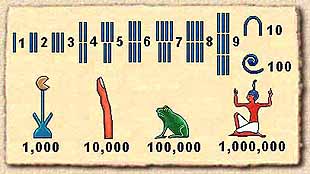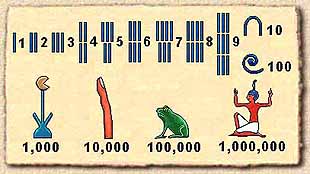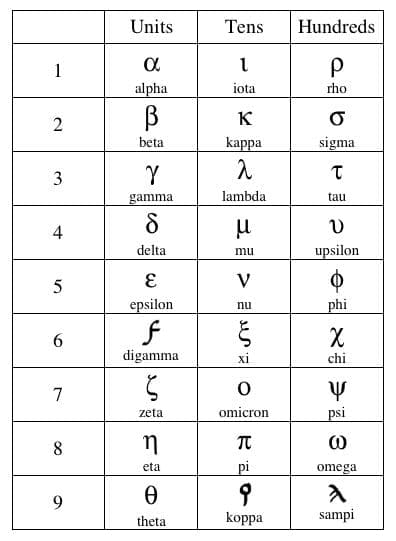
One of my first lessons when teaching or tutoring a gifted/talented child or group of any age/grade in math is always the history of the number system and a comparison of number systems. They are almost always fascinated and it leads to fantastic mathematical discussion. Teaching the history of the number system is a great lead in to the typical beginning of the year lessons on place value as we can discuss how our number system is based on 10 and why that matters.
The History of Counting
By far the best children’s book I have found for introducing this concept is The History of Counting by Denise Schmandt-Besserat. While this is an illustrated picture book (Amazon mistakenly has age range from 4-8) the text is dense and the information rich. It is definitely appropriate for upper elementary and middle school students.
As one of the Amazon reviewers says, “I discovered this book while homeschooling two middle school boys (6th and 8th grade)… We’ve been studying ancient civilizations this year, and this book fits in perfectly. We recently studied Egyptian hieroglyphics (including how numbers were represented) and this heightened my sons’ interest in the discussion (on pp. 28-29) of the numeric symbols used by Greeks and Romans. Last year we read that the Arabs invented zero, and it was interesting this year to discuss how Egyptians, Greeks and Romans were able to do without a symbol for “nothing” and how important zero is to the concept of place value.”
Another great book is Can You Count In Greek? Exploring Ancient Number Systems. This book was written for gifted students in 5th-8th grade. According to the Amazon description: “Students will learn about the number systems of the Mayans, Babylonians, Egyptians, Romans, and Hindu-Arabic cultures, and also about quinary and binary systems. Symbols and rules regarding the use of the symbols in each number system are introduced and demonstrated with examples. Activity pages provide problems for the students to apply their understanding of each system.”

The other book I have used for younger students is Fun With Numbers, published by World Book. I have not been able to find this one online though.
Sumerian/Babylonian Numbers

Since the very first mathematics can be traced to ancient Babylon, this is important to introduce. The Sumerian base 60 system for counting is still the reason behind our hours, minutes, and seconds and the way we divide a circle into 360 degrees. According to Explorable, “the Babylonians believed that there were 360 days in a year, and this formed the basis of their numerical system; they divided this into degrees and this represented the daily movement of the sun around the sky. They then transferred this into measuring circles by dividing degrees into minutes. Our entire system of astronomy, geometry, and dividing the day into hours, minutes and seconds hails from this period of history.”
Here is some great information from The Story of Mathematics.
A fun activity is to make clay “Cuneiform tablets” and carve the numeric symbols with a pointed stick.
Here’s a free printable challenge activity from Eduplace for adding and subtracting with Sumerian numbers.
Egyptian Numbers
One of the main number systems I have my students explore is the Egyptian number system. The Egyptians had a bases 10 system of hieroglyphs for numerals. They invented special symbols for the numbers 10, 100, 1000, 100000, 100000, and 1000000. My students enjoy discussing why they chose the symbols they did. (These include finger stroke, arch, curved rope, lotus flower, bent finger, tadpole, god.) We practice reading and writing different numbers.

Discovering Egypt has a great webpage showing the numbers. It explains how the Egyptians used fractions, and gives some word problems for students to solve. It also has a hieroglyphic calculator and typewriter.
Math Cats has more information on Egyptian fractions.
The Children’s University of Manchester has an online activity for kids called Egyptian Number System. This is part of their Ancient Egypt Learning Adventure.
The Three Pyramids is an interactive game from The National Museum of Scotland.
For more detailed information on the history of Egyptian mathematics including the hieratic numerals used after the invention of writing on papyrus, this is a great source.
Roman Numerals

It is interesting to me how fascinated my GT students almost always are by Roman numerals. They enjoy the addition/subtraction aspect of reading and writing the numbers and see it as kind of like a code!
Speaking of codes here is a free “Crack the Code” hidden message activity from TPT using Roman numerals to figure out a quote from Caesar.
Maths No Problem has a variety of strategies, activities and games for teaching Roman numerals.
Here is a free printable Roman numeral poster from Innovative Teaching Ideas on TPT.
Here is a free I Have Who Has Roman numeral game for the classroom.
And here is a free printable Roman numerals magic square activity.
Finally, if your students LOVE working with Roman numerals like my students do, here are 100 word problems (with detailed solutions) using Roman numerals!
Greek Numerals
I don’t go too far into Greek numbers with my students other than showing them there was a system, and that the early system was similar to Roman numerals. As kids.net.au says, “The earliest system of numerals in Greek was acrophonic, operating much like Roman numerals with the following scheme: Ι = 1, Π = 5, Δ = 10, Η = 100, Χ = 1000, and Μ = 10000. Starting in the 4th century BC, the acrophonic system was replaced with a quasi-decimal alphabetic system, sometimes called the Ionic numeral system.”
Here is some information from Maths Is Good For You.

Mayan Numbers
The Mayan number system is based on 20. It is widely believed that this is because we have 20 digits to count with–ten fingers and ten toes. The Mayans along with the Hindus are important for inventing the concept of zero.

An online Mayan math game is available from The Smithsonian National Museum of the American Indian. They also have a follow up lesson for using the Mayan system to multiply. (and comparing it to Base 10.) It is designed for 7th/8th grade but younger GT students could also do it.
Here is a free “code cracking” printable puzzle using Babylonian, Egyptian, AND Mayan symbols.
Hindu Arabic Numbers
Academic Kids has a great article about the development of Hindu Arabic numbers.
For specific lessons on Fibonacci, see this post.

Additional Resources
My post Math Movies For Students has several choices that would be a great addition to teaching the history of the number system, especially The Story of One.
See my post Picture Books About Mathematicians for books to teach children about famous historical mathematicians.
Also see Timeline of Mathematics on Mathigon.
